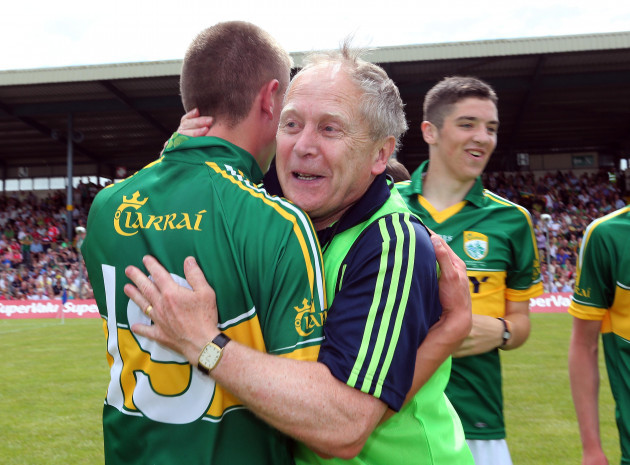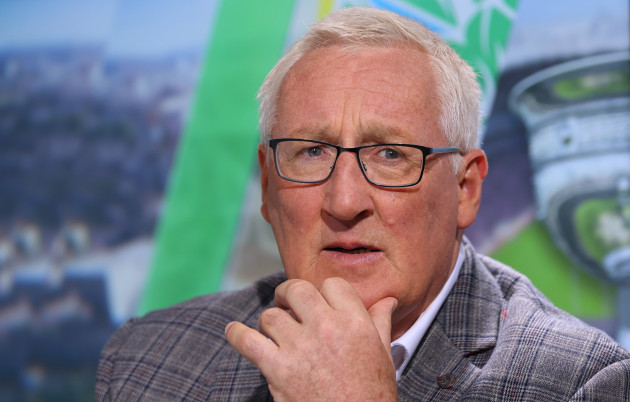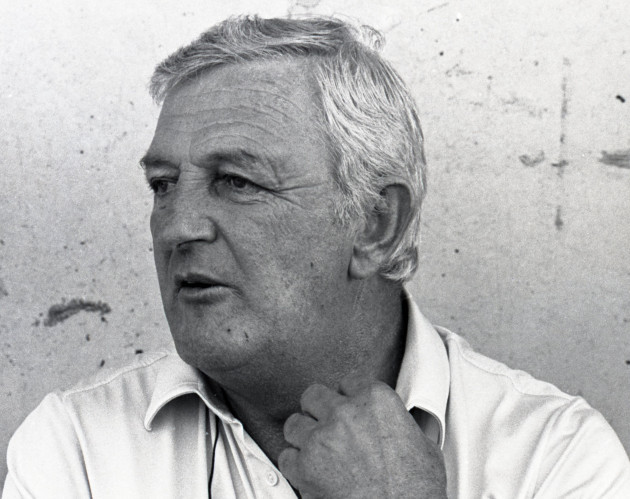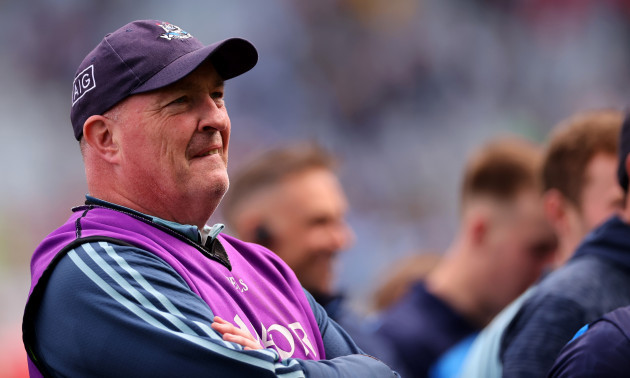TAKE YOURSELF BACK to late 2003 and the moment when Jack O’Connor was becoming Kerry manager for the first time.
Inside his head was a maelstrom of conflicting emotions. He wanted the job and he didn’t want it. One overrode the other and he was dealing with his mother’s passing the very day he was handed the responsibility of being Kerry manager.
Above everything, his strongest doubt was that he wasn’t a ‘Made Man’. The Golden Years generation was still keen on keeping the umbilical cord. He was coming in from the cold.
Then, think of last year and the warm and fuzzy picture of Jack O’Connor bringing Sam Maguire for a house visit to Micko. O’Connor never asked to be part of a Golden Circle, but this was a sure acknowledgment that the two men were meeting on an equal footing.
The man who took the picture was Cian O’Connor, son of Jack. He recalled the circumstances around it.
“I took a load of photos of them together but there was one of them in deep conversation that was the standout.
“It was just the way that Jack was looking at Micko, and Micko had his hand on the cup.
“I knew straightaway that this was a powerful picture which sums up all that is good about Kerry football. It is never about one man – it is about tradition.”
When Micko got a visit from his lifelong friends SAM & Jack #ThisIsKerry 💚💛 pic.twitter.com/cFUkI4Mtre
— Kerry GAA (@Kerry_Official) July 29, 2022
The subject of legacy surrounds Sunday’s final. Can Jack go back-to-back? The first Kerry manager to do it since Micko?
Will James McCarthy, Mick Fitzsimons and Stephen Cluxton secure a ninth All-Ireland football medal?
Take a step back from all the various permutations of what a positive result might look like for either county this Sunday and there is a significant difference in what exactly the ‘legacy’ of Gaelic games is in each county.
Last October, the former Kerry manager and 1975 All-Ireland winning captain Mickey Ned O’Sullivan delivered a lecture at the Daniel O’Connell school in Cahersiveen, exploring that open-ended question – ‘What is it about Kerry football?’
What is it that people like? Why does everyone follow them? Why is there such a need?
O’Sullivan’s theory was that the unifying role that Kerry football played in the wake of the Civil War cemented it as the most important thing in the county.
The respected sports writer and author of ‘Princes Of Pigskin: A Century of Kerry Footballers’, Joe Ó Muircheartaigh, wrote a piece with O’Sullivan this week.
“Lads who were shooting each other in 1923 could come together to play for the Kerry team in 1924,” he explained.
“Everyone in the county saw this and it was an early thing that people latched onto.
“They had won five All-Irelands before that, and then once they won six All-Irelands in nine years, that was that. Everyone was with Kerry then.”
The political side of things was not allowed to fester. Joe Barrett had been the captain in 1929 and 1932. He was also a prominent Anti-Treaty Republican who, while imprisoned, had embarked upon a 22-day hunger strike.
And yet he passed the captaincy, at his request, to Con Brosnan, the Irish Free State army captain.
“He was making the point that if he could do that, even though he got awful stick from Republicans around Tralee who ostracised him, he was an IRA man giving captaincy to Brosnan, who was in the Irish Army, who subsequently became a Blueshirt,” explained Ó Muircheartaigh.
“He was making the point that when he did this, Kerry football was above everything.”
And so it went from there. Football snuck into every crevice of Kerry life. Music became football-themed. Kerry football itself in modern times became a pop-up industry with former players Paddy Bawn Brosnan, Páidí Ó Sé and Pat Spillane operating busy bars.
Music was football-themed or a natural accompaniment to football culture. Sigerson Clifford, who wrote so much moving poetry about Kerry, sprinkled football references everywhere through his work.
And, oh boy, did Kerry not take up the oral tradition of storytelling and yarns when it came to football. It became the major and dominant obsession.
It wasn’t just confined to pubs and terraces. It was ingrained in players too. Mickey Ned said that when they came to play Dublin in the 1975 final, it was the first time that pairing came together in a final in two decades.
“He was telling me that his team of the ‘70s, they were very aware of the 1955 final against Dublin and how important it was to beat them,” said Ó Muircheartaigh.
“And he was telling me that the current crop, they are acutely aware of that as well. Of what the other Kerry teams have done before them, against Dublin in particular.”
It’s curious that in 30 years of punditry and newspaper columns, the story of Pat Spillane’s father, Tom, never became known on a national scale until Kerry’s win in the final last year when Pat let it all out in his final Sunday Game broadcast.
Spillane’s father Tom had died in 1964, just days after the All-Ireland final win over Galway. He had been a selector with the Kerry team. Before that, he was on the Kerry panel that played the 1947 All-Ireland final against Cavan in New York’s Polo Grounds.
Pat’s uncles were the three Lyne brothers on the other side.
An example of how politics and sport mixed is found right here, as Jackie Lyne married a sister of Liam Lynch, one of the leading Anti-Treaty figures.
For his work documenting Kerry footballers, Ó Muircheartaigh had cause to visit Mick O’Connell twice in his life. Once for an interview, the second to set up a photograph.
While there, a steady stream of visitors turned up, unannounced. At one point, a priest from Clare of Ó Muircheartaigh’s acquaintance arrived. He presumed he must have known O’Connell, but, not at all. A family from Tyrone turned up. All were brought inside the house.
And the odd thing is, you don’t get that in other counties. It doesn’t resonate like that. In Kerry, they embrace it. Streets and roads are named after their past players; you have the John Joe Sheehy Road which leads to Austin Stack Park in Tralee.
You have the Joe Keohane Roundabout. The Dan Spring Road. The Bracker O’Regan Road.
They have a place in the social fabric of the town because of what they did on the Gaelic football field and they are remembered as a result.
In Dublin, it isn’t like that at all. Ó Muircheartaigh would know. He was born and bred in Dublin before moving to live in Ennis, and now on the Dingle peninsula.
“Because Dublin is so cosmopolitan. You could ask a fella, where is the heart of Dublin football, and he would say St Vincent’s. Around there, Kevin Heffernan and that,” he explains.
“But there are loads of people around that area of Marino that mightn’t have been to Croke Park. That might not know that Dublin are playing in an All-Ireland final. It would go over their head.
“Whereas in Kerry, everyone is so invested in the fortunes of the team. And when it’s against Dublin, it’s that country versus city thing that motivates.”
Heffernan was the ultimate game changer. Domestic Irish soccer had some high points in the 1950s and the ‘60s, somewhat powered by the allure of the 1966 World Cup held in England.
Despite Heffernan captaining Dublin to the 1958 All-Ireland title, within a decade, GAA in the city was on its knees.
David Hickey was later to say that if you were a Dublin player around this time, you wouldn’t be inclined to admit it to too many people.
Asked about how different the interest in Gaelic Games in 1968 compared to a decade previously, Heffernan told an RTÉ broadcast in 1970: “Well, there’s a tremendous difference. I think there’s a terrible decline in the interest.
“For instance, last Sunday we played a National League match on Sunday against Armagh in Croke Park and we had barely a handful of supporters.
“Whereas ten years ago in 1958, we had a cavalcade of people following us through the dead of winter.
“The games were a normal topic of conversation among people in the town. Now, virtually nobody talks about Gaelic Games.”
Heffernan managed to capture that excitement that people held for soccer teams, at the same time as the Irish soccer league was going into steady decline.
He brought the titles back. And his clubmate Pat Gilroy laid the foundations of dominance that followed. They might stop short of re-naming roads and streets and it will always be too cool and cosmopolitan to make capital out of the efforts of their footballers.
But all the same, Dublin became the biggest show in Irish sport. The only show.
This week, James McCarthy says all this stuff around legacy is not on his mind as he bids to become the record holder of nine All-Ireland medals. He says he might live off it, some day when lying against the bar of the Autobahn in Ballymun, a popular local drinking spot.
Equally, you could see him left completely alone in the same scenario. And he’d prefer it that way.






